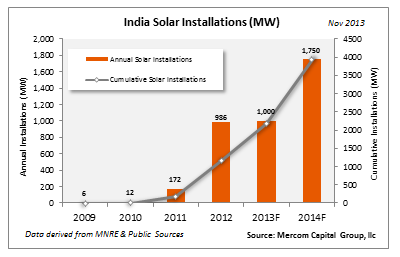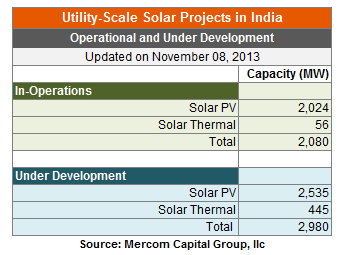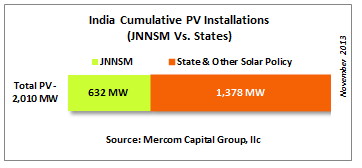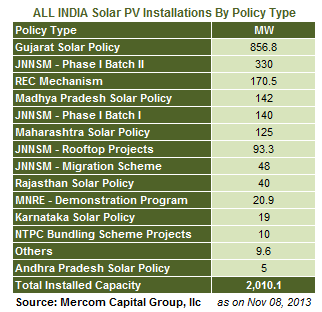KOLKATA – Nov 20, 2013 – It has been a quiet year for the Indian solar sector, with installations at 900 MW so far this year and final numbers forecasted to be similar to last year. With 420 MW of CSP projects missing commissioning dates, India is not likely to register any significant year-over-year installation growth for 2013, even as global solar market is forecasted to grow ~20%.
 The guidelines and requests for selection (RfS) have finally been published for Phase II Batch I, for 750 MW of PV projects. Unfortunately, India has decided to include domestic content requirements for half (375 MW) of PV projects, which may be enough to cause a trade dispute but not enough to help domestic manufacturers. It is an unnecessary risk that raises uncertainty with minimal reward.
The guidelines and requests for selection (RfS) have finally been published for Phase II Batch I, for 750 MW of PV projects. Unfortunately, India has decided to include domestic content requirements for half (375 MW) of PV projects, which may be enough to cause a trade dispute but not enough to help domestic manufacturers. It is an unnecessary risk that raises uncertainty with minimal reward.
According to the proposed time line, these 750 MW of JNNSM Phase II projects will not be commissioned until at least May 2015. Therefore, projects under Indian state schemes are where the action will be in 2014.
The challenges faced by the Indian economy this year also affected solar industry. This year the market has seen high inflation, a ~8 percent rise in module prices and a ~15 percent rupee depreciation, all of which contributed to overall project costs. At the same time, reverse auctions in India continue to defy odds and go in the opposite direction with record low bidding, especially in states that have an L1 type bidding mechanism (lowest bid must be matched by all) in place. Current economic conditions, solar irradiance and off-taker creditworthiness do not look to be reflected in these bids. With bids fluctuating almost 50 percent over the year when comparing state-to-state, it is imperative to have deep insight and market intelligence to be successful in this environment.
India is entering election season with state elections in Chhattisgarh, Madhya Pradesh, Mizoram, Rajasthan and Delhi due next month. According to the guidelines by the Election Commission of India, non-agricultural land transactions cannot be approved by the government during election season without the approval of the Chief Electoral Officer. This will delay any solar projects that are in the middle of land acquisitions by a few months.
 With some states yet to sign PPAs and upcoming state and general elections, our preliminary estimates are tentatively at 1,750 MW of solar installations in India for 2014. Although the projected installation growth looks impressive, it includes 420 MW of CSP projects that did not get installed in 2013.
With some states yet to sign PPAs and upcoming state and general elections, our preliminary estimates are tentatively at 1,750 MW of solar installations in India for 2014. Although the projected installation growth looks impressive, it includes 420 MW of CSP projects that did not get installed in 2013.
Local solar industry views on current market conditions
Project developers we talk to are not sure they can make profits at the low bids we see in some states, though there are a few states with healthy tariffs. Their opinion is that the viability gap funding (VGF) mechanism was unnecessary as they thought that the current model was working. The consensus is that the disbursement of VGF is too complicated and takes 5 years to get reimbursed compared to immediate payment after completion for other infrastructure projects. While some developers said they would bid for projects both with and without domestic content requirements (DCR), their concern was that financing will be challenging with a 5 year VGF payment period. This may work for large companies with large balance sheets, but less so for developers looking for non-recourse financing. Considering that the planning commission has already acknowledged problems with the VGF and the public-private partnership model and is working on a draft bill to fix some of these issues, it is baffling as to why they would continue to experiment with a model that is obviously problematic, especially in a new sector like solar.
All the developers we spoke with agree that margins are razor thin; most bids do not take solar irradiation, inflation, currency depreciation, and off-taker creditworthiness into account. A tariff of ₹6.50 (~$0.11) in one state is not the same as a ₹6.50 (~$0.11) tariff in another. Developers are hoping to see a correction phase where bids go up in line with current market conditions. However, concerns remain that too many inexperienced firms are bidding recklessly. This is typical in most of the infrastructure projects in India. The message from developers is to keep it simple and consistent; there is no need to experiment if something is working. There needs to be strict enforcement of rules already implemented instead of bad behavior being rewarded.
 Utility push back against captive generation is a very interesting development brought to our attention. We hear that utilities are objecting and putting up hurdles against large corporations starting captive power projects. They are afraid to lose these big paying customers but they also are not providing quality power without cuts. This is a development we will continue to monitor.
Utility push back against captive generation is a very interesting development brought to our attention. We hear that utilities are objecting and putting up hurdles against large corporations starting captive power projects. They are afraid to lose these big paying customers but they also are not providing quality power without cuts. This is a development we will continue to monitor.
Surprisingly, manufacturers were upbeat, feel that demand has improved, and hope for continued domestic content requirements. In our conversations with manufacturers representing close to 50 percent of the solar manufacturing capacity in India, capacity utilization rates were quoted in the 70-100 percent range, which is completely at odds with the ~25 percent utilization rates quoted in the media in an effort to get help from the government. The average selling prices quoted were in the $0.65-0.70/W (~₹39-42/W) range. Some local manufacturers have started manufacturing modules for Chinese companies, which then get shipped to Europe. Price pressure remains the single biggest challenge for local manufacturers.
Financial institutions are very focused on quality projects that have strong credible partners and good EPC providers. Panel manufacturer credibility is very important to some banks. One large bank said that they have not yet financed a single project so far that is using domestically-manufactured panels. They see DCR as a concern. Because of low bids and credit rating of utilities, banks, fearful of inconsistent payments, are concerned about lending to projects. Most said that they need more clarity before they will lend on VGF projects.
Update on Select India State Policies
JNNSM – Phase I
Phase I Batch I: PPAs for Batch I projects were signed for 610 MW (140 MW-PV, 470 MW-CSP). 140 MW of PV projects have been commissioned and only one 50 MW CSP project has been completed out of the 470 MW that were originally due to be commissioned by May 2013. The remaining projects have been given an extension until March 2014. Our due diligence indicates that 150 MW of the 470 MW CSP projects are in advanced stages of development. Once commissioned, these projects will receive tariffs between ₹10.49-12.24 (~$0.18-$0.20), a premium of almost 40-50 percent over new PV projects (most of which are currently bidding in the ₹6.50-8.00/~$0.11-0.13 range). These projects will not be penalized for delaying up to a year. It is time to eliminate the required PV:CSP ratio for good and let the market decide on the best and most cost-effective technologies.
Phase I Batch II: 330 MW of the 340 MW in Batch II have been commissioned with the remaining 10 MW delayed and most likely will be canceled.
JNNSM – Phase II
 As previously mentioned, after almost a year of delays, final guidelines and RfS for JNNSM Phase II Batch I were published recently. 750 MW of grid-connected PV projects will be auctioned under the viability gap funding scheme. Because of the delay in announcing Phase II, these projects are not expected to be commissioned until at least May 2015.
As previously mentioned, after almost a year of delays, final guidelines and RfS for JNNSM Phase II Batch I were published recently. 750 MW of grid-connected PV projects will be auctioned under the viability gap funding scheme. Because of the delay in announcing Phase II, these projects are not expected to be commissioned until at least May 2015.
Out of the 750 MW, 375 MW will have a separate bidding process and will have a domestic content requirement under which solar cells and modules used must be made in India. Developers can either opt to bid for “DCR” or “open” categories. The “open” category will have no domestic content requirement.
Under VGF, developers will sign a PPA for 25 years to sell power at a fixed tariff of ₹5.45/kWh (~$0.09/kWh). In the case of accelerated depreciation, the tariff will be reduced by 10 percent to ₹4.75/kWh (~$0.08/kWh). The maximum limit for VGF is 30 percent of the project cost, or ₹2.5 crore/MW (~$416,667/MW), whichever is lower.
There have been some mechanisms added to ensure project performance; a minimum capacity utilization factor (CUF) of 17 percent over a year has been set. Projects have to maintain a CUF within -15 percent and +10 percent of their declared value until the end of 10 years from Commercial Operations Date subject to the CUF remaining over a minimum of 15 and within -20 percent and +10 percent thereafter until the end of the PPA duration of 25 years.
Another major change in the guideline compared to the draft proposal is the payment schedule which has not been welcomed by developers. The VGF payment will be released in tranches: 50 percent on successful commissioning of the full capacity of the project, and the rest progressively over the following 5 years (10% each year) subject to the project meeting generation requirements (CUF) within a specified range per the policy guidelines.
Here is a factsheet summarizing JNNSM Phase II, Batch I guidelines – http://www.mercomcapital.com/guidelines-for-grid-connected-solar-pv-projects-in-india-phase-ii-batch-i-fact-sheet
Tamil Nadu: Tamil Nadu announced a 1,000 MW tender in December 2012 for PV projects. Tamil Nadu used an L1 bidding process. Fifty-two developers have signed letters of intent (PPA due to be signed shortly) for a total of 698 MW at ₹6.48 (~$0.11/kWh). Developers have 10 months to commission these projects from the date of PPA signing.
Tamil Nadu Generation and Distribution Corporation (the state owned utility and off-taker also referred to as TANGEDCO) is also considered a high-risk off-taker due to its poor credit-worthiness and history of delayed payments.
Gujarat: Gujarat currently has 857 MW of PV projects commissioned under its state policy, the most of any Indian state so far. Gujarat, known as the most business-friendly state, inexplicably sought to cut the tariff rate it pays to projects, citing excessive profits from project owners. The petition for this cut was rejected but we confirmed that Gujarat Urja Vikas Nigam Limited (GUVNL) is planning to file an appeal with regulators.
It will be a crushing blow to Gujarat’s reputation as a business-friendly state if it continues to pursue this path of retroactive tariff cuts. There is nothing that business and investors hate more than retroactively changing laws.
Andhra Pradesh: The government of Andhra Pradesh has decided to allow any company to set up a solar project in the state at ₹6.49 (~$0.11) per kWh, including those who have not participated in the recently-concluded competitive bidding for 1,000 MW. PPAs have been signed for 147 MW of PV projects and another 125 MW of PPAs will be signed soon according to Transmission Corporation of Andhra Pradesh Limited (APTRANSCO). No solar projects are expected to be commissioned this year.
Eastern Power Distribution Company of AP Limited (APEPDCL), in association with New and Renewable Energy Development Corporation of Andhra Pradesh (NREDCAP), has launched net metering to encourage consumers to produce solar power. Under this scheme, domestic users would be allowed a maximum subsidy of 50 percent of the cost of installing a solar rooftop project (up to 3 kW).
The Government of India has also given its initial go-ahead on splitting the state of Andhra Pradesh into two states, Telangana and Andhra Pradesh which could happen next year.
Punjab: Of the 300 MW proposed, Punjab opened bidding for about 250 MW of PV projects. With average tariffs ranging between ₹8.20-8.40 (~$0.13-0.14)/kWh, PPAs are expected to be signed for these projects next month. The delay in signing PPAs can be attributed to land acquisition problems and delays due to upcoming elections.
Uttar Pradesh: Uttar Pradesh opened bidding for about 130 MW of PV projects, with average tariffs ranging between ₹8.01-₹9.33 (~$0.13-$0.16)/kWh, which is probably the best in India right now along with Punjab. PPAs for these projects are expected to be signed in the next few weeks.
Kerala: The 10,000 rooftop solar power plant program is currently being implemented out of which approximately 6,000 installations are complete. The remaining 4,000 installations are expected to be complete by December 2013. These projects are up to 1 kWp in size and for captive use.
Under a competitive procurement policy, the government expects to develop 330 MW of solar projects of which 50 MW are under construction and due to be commissioned by December 14, 2013.
Rajasthan: To date, there are 40 MW of solar projects installed under Rajasthan’s state policy. Bidding for 75 MW of solar projects took place in March 2013. The land allocation for these projects is in progress, but delayed due to upcoming elections.
Rajasthan Renewable Energy Corporation Limited (RRECL) has also invited an RfP for selection of 50 solar projects of 1 MW each; the deadline for which is extended until November 25, 2013.
Note: Dollar-rupee conversions were calculated at $1.00 = ₹60.
About Mercom Capital Group
Mercom Capital Group, llc is a clean energy communications and consulting firm with offices in the U.S. and India. Mercom consults with its clients on market entry, strategy, policy, due-diligence and joint-ventures. For more information, visit: http://www.mercomcapital.com

